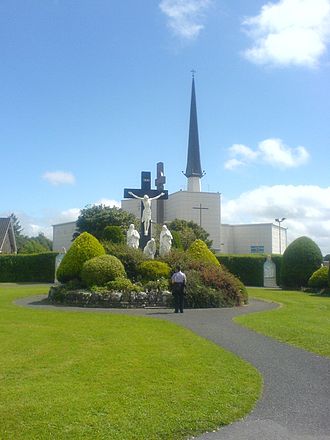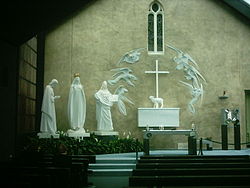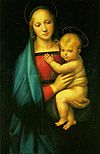- Knock Shrine
-
Knock Shrine (Irish: Scrín Chnoc Mhuire) is a major Roman Catholic pilgrimage site and National Shrine in the village of Knock, County Mayo, Ireland, where it is claimed there was an apparition of the Blessed Virgin Mary, Saint Joseph, Saint John the Evangelist and Jesus Christ (as the Lamb of God) in 1879.
Contents
Details of the apparition
On the evening of 21 August 1879, people whose ages ranged from five years to seventy-five and included men, women, teenagers, children, witnessed what they claimed was an apparition of Our Lady, Saint Joseph, and Saint John the Evangelist at the south gable end of the local small parish church, the Church of Saint John the Baptist. Behind them and a little to the left of Saint John was a plain altar. On the altar was a cross and a lamb (a traditional image of Jesus, as reflected in the religious phrase The Lamb of God) with adoring angels.
The Blessed Virgin Mary was described as being very beautiful, standing a few feet above the ground. She wore a white cloak, hanging in full folds and fastened at the neck. The crown appeared brilliant, and of a golden brightness, of a deeper hue, than the striking whiteness of the robe she wore; the upper parts of the crown appeared to be a series of sparkles, or glittering crosses. She was described as "deep in prayer", with her eyes raised to heaven, her hands raised to the shoulders or a little higher, the palms inclined slightly to the shoulders. Bridget Trench "went in immediately to kiss, as I thought, the feet of the Blessed Virgin; but I felt nothing in the embrace but the wall, and I wondered why I could not feel with my hands the figures which I had so plainly and so distinctly seen".
Saint Joseph, also wearing white robes, stood on the Virgin's right hand. His head was bent forward from the shoulders towards the Blessed Virgin in respect.
Saint John the Evangelist stood to the left of the Blessed Virgin. He was dressed in a long robe and wore a mitre. He was partly turned away from the other figures. He appeared to be preaching and he held open a large book in his left hand.
To the left of St. John was an altar with a lamb on it with a cross standing on the altar behind the lamb.
Those who witnessed the apparition stood in the pouring rain for up to two hours reciting the Rosary, a traditional Catholic prayer. When the apparition began there was good light, but although it then became very dark, witnesses could still see the figures very clearly - they appeared to be the colour of a bright whitish light. The apparition did not flicker or move in any way. The witnesses reported that the ground around the figures remained completely dry during the apparition although the wind was blowing from the south. Afterwards, however the ground at the gable became wet and the gable dark.
To put it in its historical context, this apparition took place only nine years after the declaration of papal infallibility, and shortly before the death of Archbishop MacHale.
Church Commissions of inquiry
An ecclesiastical Commission of inquiry was established by the Archbishop of Tuam, Most Rev. Dr. John MacHale. The Commission's final verdict was that the testimony of all the witnesses taken as a whole is trustworthy and satisfactory. At a second Commission of inquiry in 1936, the surviving witnesses confirmed the evidence they gave to the first Commission.
Cultural context
Subsequent sociologists, while neither accepting nor disputing what had allegedly occurred, but seeking to understand its cultural context, noted the timing of the events: how as at Lourdes and Fatima the "visitations" occurred at a time of immense cultural, social and economic change, and occurred to people whose traditional society was under threat from dramatic change. In the 1870s, Ireland was undergoing a period of dramatic upheaval. Some parts of the island had experienced what proved to be the last waves of a famine but which nevertheless brought back memories of the Great Irish Famine of the late 1840s that had decimated the countryside.
The appearance of railways brought new travel opportunities and challenges to closeknit communities, while the 1870s saw the beginnings of land reform that would change Irish rural life, reform initially fought for through mass mobilisation and sometimes violence in the Land War, led by organisations like Michael Davitt's Land League and through the radical political leadership of Charles Stewart Parnell. The land agent Captain Boycott, who was ostracised in 1880 on account of seeking rents from tenant farmers during a rent strike, became a worldwide cause célèbre, so creating the verb to boycott meaning "to ostracise completely", was also based in County Mayo. In a time of change, symbols like the Virgin Mary and St. Joseph (known together within Catholicism as the Holy Family) marked a reminder of stability and tradition in a society whose change many people found bewildering. Depending on whether one accepted the veracity of the accounts of apparation or the religious beliefs underpinning it, it could be seen either as a delusion by a marginalised traditional society clinging to old certainties, or, in a Catholic religious context, the appearance of the "Mother of God" to people marginalised by society to show her support and offer her comfort.
A similar apparition reported by another teenaged girl at Lourdes, France, in 1858 had been well publicised across Ireland by 1879. In turn, the long-standing Catholic devotion to Mary had been emphasised by the new feast of the Immaculate Conception that was proclaimed in 1854.
Many Irish rural communities were occasionally prone to visions linked to religious matters. Primary education was controlled by the churches and had more religious content than today's schools have. The apparition story was published fifteen years before the different but equally remarkable case of Bridget Cleary.
Archdeacon Kavanagh
General articles
Overview of Mariology •
Veneration of the Blessed Virgin • History of MariologyExpressions of devotion
Art • Hymns • Music • ArchitectureSpecific articles
Apparitions • Saints • Popes • Societies • Hearts of Jesus & Mary • Consecration to MaryThe parish priest at the time of the apparition was The Very Reverend Doctor Bartholomew A. Kavanagh, who was also Archdeacon of the diocese. It has often been said it was no coincidence that the Virgin Mary chose to appear in Knock while Kavanagh was the parish priest. Widely considered a very holy priest in spite of his siding with landlords against the growing Land League movement, he was appointed parish priest of Knock-Aghamore in 1867, and was about 58 at the time of the apparition. He died in 1897 and is buried in the Old Church.
The pilgrimage site
The growth of railways and the appearance of local and national newspapers fueled interest in the small Mayo village. Reports of "strange occurrences in a small Irish village" were featured almost immediately in the international media, notably The Times (of London). Newspapers from as far away as Chicago sent reporters to cover the Knock phenomenon, while Queen Victoria asked her government in Dublin Castle to send her a report about the event. In later years Catholic nationalists used the apparition to symbolically challenge Queen Victoria and her descendants' position in Ireland using for Our Lady of Knock the title Our Lady, Queen of Ireland.[citation needed][when?]
Knock today
Though it remained for almost 100 years a major Irish pilgrimage site, Knock established itself as a world religious site in large measure during the last quarter of the twentieth century, largely due to the work of its longtime parish priest Monsignor James Horan.Horan presided over a major rebuilding of the site, with the provision of a new large Knock Basilica (the first in Ireland) alongside the old church, which could no longer cope with visitor numbers.[citation needed] In 1979, the centenary of the apparition, Pope John Paul II, himself a devotee of Mary, visited Knock Shrine and stated that it was the goal of his Irish visit. On this occasion he presented a Golden Rose, a seldom-bestowed token of papal honour and recognition.
Controversially, Horan secured from Irish Taoiseach Charles Haughey millions of pounds of state aid to build a major airport near Knock. The project was condemned by critics in the media. At the time the Irish economy was in depression with massive emigration. Contrary to the critics' expectation however - and with the advent of low-fare and discount airlines - Horan International Airport (now known as Ireland West Airport Knock) became a commercial success, drawing not just pilgrims as well as passengers, but also becoming the air-gateway for the whole of Connacht.[citation needed]
Purported solar phenomena
In October 2009, Knock was in the news when many people reported observing "miraculous" solar phenomena similar to the Miracle of the Sun widely believed to have occurred at the time of the Fatima apparitions. The phenomena had been "prophesied" by Dublin-based mystic Joe Coleman a few weeks earlier; however the reports have been met with scepticism and the local Archbishop has warned Catholic congregations against putting any faith in these phenomena.[1] [2]
After the pilgrims had left the shrine after this event, the manager had to call in industrial cleaners to remove the rubbish left, including spilt food and drink.[3][4] He also said that he would review whether gatherings would be allowed, citing health and safety issues as one problem.[3]
In December 2009, an ophthalmologist from University College Hospital Galway issued a warning that there had been a significant spike in the number of cases of solar retinopathy "all of them linked to events at Knock," with the observed patients having had "a significant reduction in their vision." The reports of people having observed the sun "dancing in the sky" were characterized as merely "sort of a cheap trick" caused by the extremely bright sunlight: "If you stare at the sun for long enough you're going to get some visual disturbances." The warning about the dangers of staring directly at the sun continued: "Not only will you get reduced vision but also a condition called metamorphopsia."[5]
See also
- Blessed Virgin Mary (Roman Catholic)
- Marian apparitions
- Knock, County Mayo
- Republic of Ireland
- Roman Catholic Church
- Moving statues
- Walsingham
- Shrines to the Virgin Mary
- Our Lady of Fátima
- Our Lady of Lourdes
References
- ^ http://www.independent.ie/national-news/archbishop-enters-row-over-knock-sun-miracle-1924930.html
- ^ http://www.irishtimes.com/newspaper/features/2009/1028/1224257549789.html?via=mr
- ^ a b Shrine staff forced to clean up mess left by Knock pilgrims, John Cooney, Irish Independent, 3 November 2009
- ^ Gathering at Knock 'anything but holy', says shrine manager, Steven Carroll, The Irish Times, 3 November 2009
- ^ Eye fears over holy shrine 'visions', BBC News, 2 December 2009
External links
- Official website of Knock Shrine
- Website about the town of Knock
- Horan International Airport (Knock Airport) website
- Knock Shrine Association of America
- Photo documentation
- The music for the song "Lady of Knock"
Further reading
- John MacPhilpin. The Apparitions and Miracles at Knock. PJ Kennedy. 1904
- Sister Mary Francis Clark. Three Visits to Knock. PJ Kennedy. 1904
- Neary, Tom, I Saw Our Lady.
Coordinates: 53°47′32″N 8°55′04″W / 53.79209897°N 8.91765942°W
Categories:- Marian shrines
- Roman Catholic Church in Ireland
- Catholic pilgrimage sites
- Places of worship in County Mayo
- Basilica churches in Europe
- Recipients of the Golden Rose
- Museums in County Mayo
- Religious museums
- History museums in the Republic of Ireland
Wikimedia Foundation. 2010.



